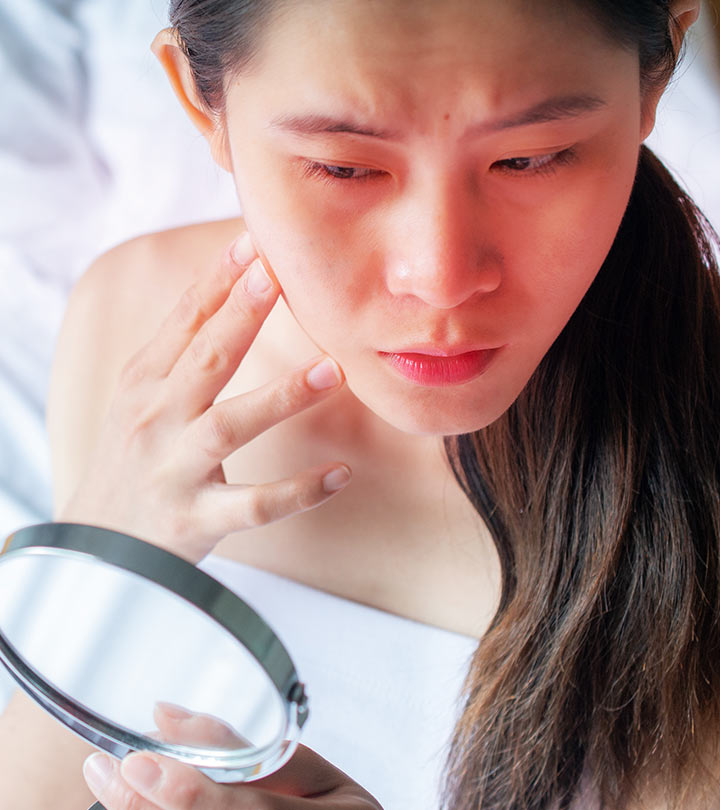Redness on the face can be caused by a wide range of factors. Sunburn, allergic reaction to a medication, overconsumption of alcohol, or even consumption of spicy food can cause your face to become red. But sometimes, redness may also be indicative of an underlying medical condition and needs to be checked by a doctor immediately. The good news is there are some simple remedies you can use to reduce the redness on your face. In this article, we explore some of the causes behind a red face and a few remedies one can try at home.
In This Article
What Causes Redness On The Face?
Shutterstock
Your face becomes red when the blood vessels dilate, causing more blood to rush to your skin. Redness may be observed not only on your face but also around your neck. This sudden redness of your skin is called flushing or transient redness. It can be a result of long exposure to sunlight, causing sunburn or a strong emotion like anger, embarrassment, stress, or any extreme emotional state.
It can also be attributed to other medical reasons, such as menopause and rosacea. Rosacea is a condition that causes the blood vessels under the skin to dilate, making your skin look red. Studies show that the causes of rosacea may be traced back to seborrhea, bacterial infection, Demodex infestation, etc. (1).
Other factors that cause redness of face are a genetic predisposition to redness of the skin, allergic reaction to certain facial products, exposure to heat or excess sunlight, over-exfoliation of skin, breakouts or acne, and excessive consumption of alcohol (2).
Stylecraze Says Eczema, psoriasis, shingles, and lupus are a few medical conditions that may cause redness on the face. It is essential to treat these underlying issues to address the redness.
In the following section, we will look at a few natural remedies that can help reduce facial redness.
Natural Remedies For Facial Redness
1. Honey
Honey has been used for ages to treat skin conditions and possesses wound healing and anti-inflammatory properties (3). It can help heal any lesions or rashes that may appear on your skin.
You Will Need
- 1 tablespoon of honey
- Sterile gauze
What You Have To Do
- Dab some honey on the sterile gauze.
- Apply it over the areas where the redness occurs.
How Often You Should Do This
Apply honey 3-4 times a day.
Related: Is Honey Good For The Face And Skin? How To Use It?
2. Aloe Vera
Aloe vera possesses anti-inflammatory and wound healing properties (4). Hence, it may help reduce the red patches that appear on your face and promote faster healing.
You Will Need
An aloe vera leaf
What You Have To Do
- Extract some gel from the aloe vera leaf.
- Apply the gel to the red patches on your skin.
- Leave it on overnight and wash off when you wake up.
How Often You Should Do This
Repeat this every night until the redness reduces.
Related: Using Aloe Vera For Dark Spots On Your Skin: Tips And Precautions
3. Chamomile Tea
Shutterstock
Chamomile tea is commonly used to treat skin problems and has anti-inflammatory properties (5). It can help in decreasing inflammation on your skin, which, in turn, reduces redness.
You Will Need
- Chamomile tea bags
- A few cups of water
What You Have To Do
- Boil a few cups of water and steep 2-3 chamomile tea bags in it.
- Cool this decoction and use it to wash your face.
- Pat your face dry.
How Often You Should Do This
Repeat this two times daily.
4. Cucumber
Cucumber is a rich source of phytochemicals that reduce the appearance of lesions and acne (6). Hence, it may also help in reducing facial redness. It also leaves the skin looking clearer and moisturized.
You Will Need
1 ripe cucumber
What You Have To Do
- Grate the cucumber.
- Use this pulpy mixture as a face mask by applying to the areas with redness.
- Leave it on for 15 minutes and wash with plain water.
How Often You Should Do This
You can apply this paste 3-4 times a week.
Related: 32 Benefits Of Cucumber (Kheera) And Side Effects
5. Yogurt
Yogurt contains probiotics. A study showed that oral probiotics could enhance skin barrier function and reduce skin sensitivity (7). This may reduce the appearance of rashes and redness on your face.
You Will Need
- 2 teaspoons of yogurt
- 1 teaspoon of lemon juice
What You Have To Do
- Mix the yogurt and lemon juice in a small bowl.
- Apply the paste to the problem areas on your face.
- Rinse with water.
How Often You Should Do This
Use this paste two times a week.
Note: Lemon can cause allergic reactions in some people. Make sure to carry out a patch test before using this remedy.
6. Green Tea Soak
Green tea contains catechins that exhibit anti-inflammatory and antifungal properties (8). These properties may help reduce the appearance of red patches on your face.
You Will Need
- 2 teaspoons of green tea leaves
- Boiled water
- Clean washcloth
What You Have To Do
- Boil a bowl of water and steep two teaspoons of green tea leaves for 5 minutes.
- Refrigerate the strained decoction for a short while and soak the washcloth in it.
- Wring it and place it on your face for 10 minutes.
- Wash your face with plain water.
How Often You Should Do This
Repeat this daily until the redness disappears.
7. Petroleum Jelly
Petroleum jelly contains a compound called petrolatum that enhances the skin’s barrier repair function and exhibits antimicrobial properties (9). These properties can help fight any infection that may cause facial redness.
You Will Need
1 tablespoon of petroleum jelly
What You Have To Do
- Apply a tablespoon of petroleum jelly on the affected areas.
- Leave it on overnight and wash off with a mild facial cleanser.
How Often You Should Do This
You can repeat this every night until the redness subsides.
8. Lavender Oil
Shutterstock
Research shows that lavender oil possesses antifungal, anti-inflammatory, and antimicrobial properties (10). These can help in fighting fungal or bacterial infections that may cause facial inflammation and redness.
You Will Need
- A carrier oil
- 2-3 drops of lavender oil
What You Have To Do
- Dilute a few drops of lavender oil with a few drops of olive oil.
- Dab it on a cotton ball and apply it to the affected areas.
- Rinse your face thoroughly after 10 minutes.
How Often You Should Do This
Do this 2-3 times daily.
9. Coconut Oil
Sometimes, an infection caused by a fungus or bacteria can cause your skin to look inflamed or red. Coconut oil contains lauric acid that exhibits antifungal properties (11). This may help fight any skin infection that may cause facial redness.
You Will Need
Virgin coconut oil
What You Have To Do
- Take a teaspoon of slightly warm virgin coconut oil and apply it to the affected areas.
- Leave it on for about an hour before washing it off.
How Often You Should Do This
Apply coconut oil on the red patches two times a day.
10. Cold Compress
Cold compresses can help soothe inflammation or rashes on your skin, thereby reducing facial redness (12).
You Will Need
- Ice water
- A washcloth
What You Have To Do
- Soak the washcloth in ice-cold water and wring out the excess.
- Place it on the affected areas for about 10 minutes.
How Often You Should Do This
Repeat this two times a day.
These were a few home remedies that can be used to reduce the appearance of red patches on your face. We will now discuss the medical treatment options available to treat the redness of the skin.
Medical Treatment Options
Shutterstock
If you have red patches on your skin, your dermatologist may suggest the following medications:
- Brimonidine tartrate 0.33% gel is a medication that is approved for use in the case of recurrent erythema that is associated with rosacea (13). It is known to have a vasoconstrictive effect, which means that it tightens blood vessels in the skin to reduce the redness on your face.
- Azelaic acid has an anti-inflammatory and comedolytic effect on breakouts and acne. This can also reduce the redness on your face.
- Metronidazole and doxycycline are antibacterial drugs that can kill bacteria on your skin and reduce redness and swelling associated with infections (15), (16).
These medicines can take a few weeks to a few months to resolve the redness of your skin, depending on the severity. Your doctor may also recommend the following medical procedures to reduce redness of skin or rosacea:
- Laser therapy: This procedure employs the use of laser light or intense pulse light to help diminish erythema, thereby reducing the redness of skin (17).
- Dermabrasion: This procedure involves the use of a wire brush to scrape off or abrade the surface of the skin that is affected (18). However, this method can cause deep cuts, scarring, and, in some cases, permanent color change.
Stylecraze Says Wheat, rye, and barley are packed with azelaic acid. You can incorporate these ingredients into homemade scrubs or look for skincare products containing them.
Let us now understand how you can prevent facial redness or flushed skin.
Prevention Tips
Shutterstock
- Avoid exposure to rapid changes in temperature as this can cause your skin to look flushed. Excessive exposure to sunlight may also cause red patches to appear on the face.
- Staying hydrated can prevent dehydration and keeps your skin replenished.
- You should refrain from consuming alcohol regularly as it can cause your skin to look flushed.
- Practice relaxation techniques, such as meditation, breathing exercises, etc. Sometimes, your skin can appear flushed as a result of stress, trauma, or any other underlying medical condition. If you suspect this is the case, please consult a therapist.
While sunburn, excess heat, spicy food, or low altitude can all cause redness on your face, more often than not, it can be easily dealt with. Before picking up any OTC cream or lotion, you can try the above-mentioned home remedies to reduce redness on face. Honey, aloe vera, cucumber, green tea, coconut oil, and petroleum jelly are all found to be helpful in restoring your normal face color and reducing redness. Understanding the trigger and treating it accordingly would help you prevent its occurrence going further.




